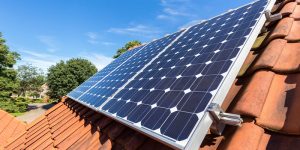Solar Energy Capture Explained
 Solar energy systems use the sun’s immense power to produce green electricity and energy savings. Its thermal energy can also be used to power your home or business using solar panels. Direct water heating,air-to-air, air-to-water and ground-source heat pumps are other ways to harness free energy.
Solar energy systems use the sun’s immense power to produce green electricity and energy savings. Its thermal energy can also be used to power your home or business using solar panels. Direct water heating,air-to-air, air-to-water and ground-source heat pumps are other ways to harness free energy.
All of these systems contribute towards massive savings on your energy bills, at the same time being kinder to the environment.
 Experience
Experience
DJK Renewables – the leading suppliers and installers of solar panels Surrey, Sussex, Hampshire and Berkshire, have been leading the renewables sector for 15 years.
Please click the headings below, for the facts.
Solar photovoltaic cells convert sunlight into electricity, which can be used to run the appliances in your home or business. They only need daylight and still generate electricity on cloudy days.
Known commonly as solar panels, or just PV in the industry, they are the large, flat panels that go on roofs to convert sunlight into electricity. PV cells come in a variety of shapes and colours, from roof and wall mounting panels to grey “solar tiles” that look like roof tiles. There are even panels available with the solar cells spaced apart to allow some sunshine through for conservatory roofing, for example.
The technology behind them is improving rapidly making them more efficient at generating electricity regardless of the weather. They are also covered by ‘permitted development’, which means you can install them without having to seek planning permission. (exceptions apply – such as installation on listed buildings).
Solar photovoltaic (PV) cells – solar panels, convert sunlight into electricity. The output of solar PV generators is measured in kilowatts peak (kWp) which represents the amount of energy they produce in full sunlight. It is this measurement which is used to calculate how many solar panels are required for a building.
Most systems use an inverter which converts the output to AC which is needed for domestic use. They are also connected to the grid, which allows electricity to be ‘imported’ when the system isn’t producing enough power (e.g. at night) and ‘exported’ when your system produces more electricity than you need. The exported surplus electricity is sold back to the grid at 3p/kwh under the Feed-In Tariffs.
Solar PV systems only need daylight, so can work in most locations. However, the output changes based upon the amount of daylight available. They will always be most efficient when placed in unshaded areas, facing at least partly South-facing. Any direction in the southerly arc between East and West will work at no less than 85% efficiency though. Output depends wholly on the strength of the sunlight, not on the outside air temperature.
No planning permission is needed for most home solar electricity systems, as long as they’re below a certain size. You should check though if your home is a listed building, in a conservation area or World Heritage site.
The inverter is usually mounted on a wall inside your property, near the solar panels, or the household consumer unit. It will usually include a meter to show how the system is performing.
Solar PV systems can be supplied in virtually any size, and their output will be related to the area of the solar panels. An area of one square metre typically can produce 100 to 180 kwatts peak of PV capacity.
The productivity of solar PV does not vary greatly across the UK. Typical levels are between 1100 kWh per square metre in the South West, to 800kWh in the Scottish Highlands.
Solar PV is an almost maintenance-free renewable energy source, as it is based on solid-state semiconductor technology. The inverter is designed to operate automatically to optimise the output of the system.
Most roof-top sloping systems will clean themselves in the rain. We do recommend a service visit once a year to check on the performance of the system and thoroughly clean the panels if accessible.








